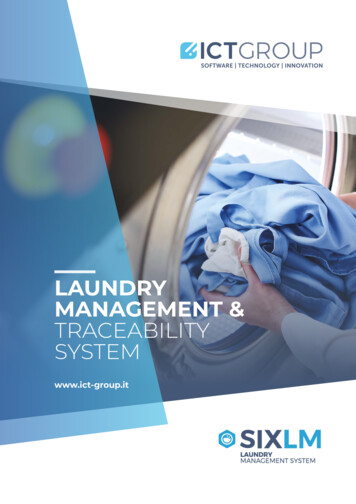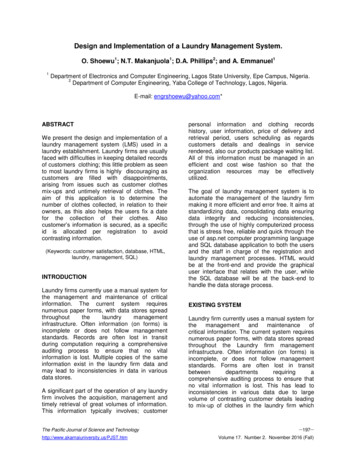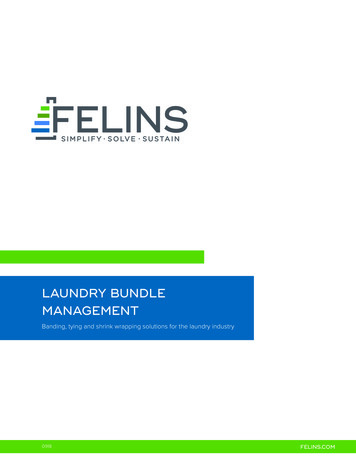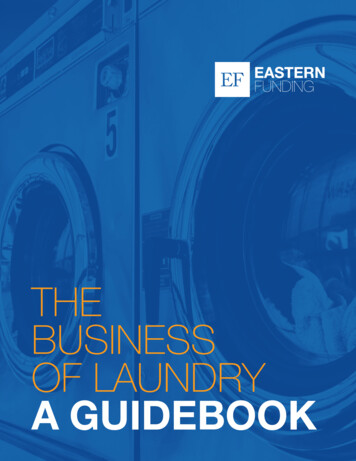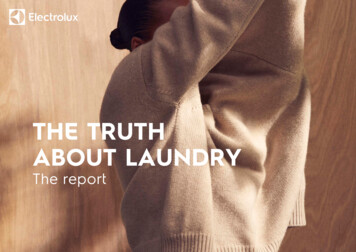
Transcription
THE TRUTHABOUT LAUNDRYThe report
The Truth About Laundry2About the reportThis report is based on the first pan-European analysis of attitudes and behaviourstowards laundry, fabric care and the environment. The study was commissionedby Swedish brand Electrolux, global leader in household appliances and a recognisedsustainability leader in the industry1. The findings in the study are based onquantitative data collected from 12,000 adults across twelve European markets*.12Europeanmarkets*Part of Electrolux’s key sustainability prioritiesis to help make clothes last twice as long,with half of the environmental impact.x2help makeclothes lasttwice as long½half of theenvironmentalimpact12 rds-and-recognitions/*Denmark, Finland, France, Germany, Italy, Norway, Poland, Russia, Spain, Sweden, Switzerland and the United Kingdom.1With that in mind the study was commissioned toincrease understanding of attitudes and behaviourstowards laundry and how people care for their clothes.Also, the aim of the study was to understand to whatextent people consider the environment when caringfor their clothes.For more information about the study go towww.betterlivingprogram.com/better-clothing-care
The Truth About Laundry3The importance of makingclothes last longerWe buy more clothes than ever, wear themfewer times and discard them at a faster rate.During the past 10 years, the number of items of clothing purchasedper consumer has more than doubled. It is expected that clothingconsumption will increase globally by 63%, from the current 62million tonnes to 102 million tonnes by 20302.By 2030clothing consumptionwill increase globally by63%62M102Mtonnestonnes201020202030The environmental cost of fashionNine out of ten items of clothing end up in landfill long beforethey should, mainly due to over- washing which can damagethe fabric, fade colours, misshape garments, cause shrinkageand spoil clothes due to colour run3.CO2Extending the life of clothes offers the greatest overall[potential across carbon, water and waste targets aluing-our-clothes-the-cost-of-uk-fashion WRAP.pdf
The Truth About Laundry4Improving how we care for clothes is an easy and important way to reduce the environmental impactand extend their lifespan. According to Fashion Revolution, an NGO with the vision of a global fashionindustry that conserves and restores the environment, up to 25% of clothing garment’s carbon footprintcomes from the way it is cared for3.10%10ANNUAL CARBONEMISSIONSTIMES BEFOREDISPOSALThe fashion industry is responsible for10% of annual global carbon emissions,more than all international flights andmaritime shipping combined5.5It is estimated that the averagegarment is worn only ten timesbefore disposal6.50%BY2030If the fashion industry’s trajectorycontinues, greenhouse gas emissionswill surge by more than 50% by 20305.https://unfashionalliance.org/ and wnloads/publications/A-New-Textiles-Economy Full-Report Updated s/2018/09/impacts of clothing factsheet ads/2018/09/impacts of clothing factsheet 23percent.pdf½OF THEFAST FASHIONIS DISPOSEDIt is estimated that more than half ofthe fast fashion produced is disposedof in under a year7.
The Truth About Laundry5Attitudes towards making clothes last longer"86% of Europeans believed that making clothes last longeris good for the environment"SELF-PERCEIVED CLIMATE-CONSCIOUSNESS86%BELIEVE IN MAKINGCLOTHES LAST LONGER78%CLIMATE CONSCIOUS22%NEUTRAL / REJECTED86% of all adults in the study believed that making clothes last longer is goodfor the environment and 83% of adults care about extending the life of clothes.78% also identified as being climate conscious with 31% strongly identifying. Atthe same time, 22% were either neutral or rejected the description. 10%GUILT RELATED TO THE ENVIRONMENT36%GUILT RELATED TOTHE ENVIRONMENT10%STRONG GUILT RELATEDTO THE ENVIRONMENT63%NEUTRAL / REJECTEDThe respondents were also asked if they felt any guilt related to the environmentwhen doing laundry. More than a third (36%) felt some guilt with 10% feeling stronglyabout it. But for 63% of respondents there was either an absence or a rejectionof guilt when it came to the impact of the environment.
The Truth About Laundry6The main reasons for doing thelaundryWhat is the main reason you wash clothes?2%2%Get rid of odoursGet rid of stains26%29%Get rid of germsLove the feeling of freshlylaundered clothesOther14%27%N/A’ OnePoll 2020; base n 11 620; total n 12 000; 380 missingThe 26% who wash primarily for the emotional benefitof wearing freshly laundered clothes, represents over409 million washes per week across Europe.This was especially common among people over the age of 55 years.Younger age groups primarily washed to tackle odours.
The Truth About Laundry7Age and doing laundryLower washing temperatures extend the life ofclothes8. More than half (53%) of all adultsthough, do not make the connection betweenwashing temperature and clothes’ longevity.It seems that age is a factor when it comes to doing laundry. Olderage groups were less likely to wash at lower temperatures thanyounger groups. Across Europe, 69% of 45–54 year olds and 71%of 55 all washed at 40 C or above. This is compared to 49% of18–24 year olds. Women were also more likely to wash at 40 Cthan men, but men were more likely to wash at 60 C.Do you think lowering the temperature of your wash would help to make yourclothes last longer?Washing at 40 C or moreYes71%55 years old69%45-54 years old49%18-24 years oldNoDon’t know33%47%82%20%’ OnePoll 2020; base n 11 620; total n 12 000; 380 missing”I care about increasingthe lifespan of clothes”At the same time, 82% of the adults responded favourably to thestatement ‘I care about increasing the lifespan of clothes’. Ofthose 82%, 50% agreed strongly and 32% somewhat cle/pii/S0143720819320431?via%3Dihub
The Truth About Laundry8Why do Europeans not washat lower temperatures?The main reason for Europeans not washing atlower temperatures was a lack of confidencein cleaning efficiency.To make Europeans lower washing temperatures,they need proof that such action will deliver thesame, if not better, results than higher temperatures.Which of the following stops you from washing clothes at lower temperatures,such as 30 C or less, more often?Which of the following would need to change for you to wash your clothes at alower temperature (30 C or less) more ntmy laundrywould becleanNot confidentmy laundrywould befree of odoursNot confidentmy laundrywould befree of germsNotconfidentit wouldremovestainsI don’ttrust mywashingmachine10%9%Noneof theseImprovements indetergentsImprovements intechnologyProof thatwashing at 30 Cor less deliversthe same resultsas a higherdegree washNew washingmachineNoneof these
The Truth About Laundry309IS THE NEWNew analysis shows that reducing the temperature from 40 C to30 C means saving 27.2 kg CO2 per appliance per year.40
The Truth About LaundrySave up to50kgCO2 equivalenta year10The importance of choosingthe right detergentThe type of detergent used can make a measurabledifference to the lifespan of clothes. Over a third of all European adults (35%) reported using powder as theirdetergent of choice.41% of Europeans reported usinga liquid detergent.41%35%Used lliquiddetergentUsed powderdetergent!Switching from powder to liquid detergent, when using a40 C wash cycle, could save 29.6 kg of CO2 equivalent peryear. By lowering wash temperatures to 30 C and switchingto liquid detergent from powder could mean saving theequivalent of 50 kg of CO2 per appliance per year.
The Truth About Laundry11The positive impact of lowering temperature andchanging detergent type from powder to liquid40 C40 CPowder100%90%Powder30 CPowder100%OTHER90%40 %30%30%30%20%20%20%10%10%10%0%0%0%CO2 equivalent*Cotton 40 C cycle using powder detergent.8kg Front Loading Washing MachineLiquid100%80%1,436kg*40 COTHER80%OTHER1,436kg*CO2 equivalent1,164kg*CO2 equivalent*Decrease temperature from 40 C to 30 C.The result is 23% less impact on GWP ofuse phase70%OTHER1,436kg*CO2 equivalent1,140kg*CO2 equivalent*Change detergent from powder to liquid.The result is 23% less impact on GWP ofuse phase
The Truth About Laundry12How often do we do laundry?One of the main contributors to clothes not lastinglonger is that we wash them too frequently. InEurope 71% of people do their laundry betweenone and three times per week.Laundry has a huge impact on the lifespan of clothes. Because ofthat it is important to try to reduce the frequency of washing bywearing clothes more often.During the pandemic laundry habits have remained pretty much thesame with 68% of people stating that their laundry frequency stayedthe same regardless and 12% had reduced the number of times theydid their laundry.Which of the following would help you to do the laundry less often?On average, how many times do you do your laundry per 7 ’ OnePoll 2020; base n 11 620; total n 12 000; 380 missing7%Washingfuller loadsWearingclothes rmore oftenWashingmixed colorstogethermore oftenSwitching thewashingmachine offfor a certainperiod eachmonthGettingothers in thehouseholdto be moreresponsiblewith theirlaundryNoneof these
The Truth About Laundry13How to make clothes last longerMaking garments last longer is key to reducing theenvironmental impact of clothes. For half of all respondents,reducing temperature played the most important part inextending garment life.Washing full loads is generally accepted (63%) to be better for the environmentbut there are two main reasons preventing people from doing so more often.44% of people do not want to wash mixed colours and 34% do not want towash mixed materials.50%50% said they would bewilling to wash at 30 C orcolder.34%34% stated that they wouldwash clothes fewer times.32%32% opted to wash fullerloads more often.28%28% of people believed in wearingclothes more often between washes.
The Truth About Laundry14The challenges withfabric conditionersFabric conditioner makes our clothes smell greatbut it has also been shown to have an adverseeffect on certain fabrics, in particular on garmentswith a breathable membrane such asoutdoor/technical wear.The reason for this is that the fabric conditioner, when added tothe wash cycle, reduces the fabric’s breathability. This loweringof performance could lead to garments being discarded longbefore they need to be.Over 4 out of 10 respondents (41%) claimed to usefabric conditioner when washing outdoor garments.
The Truth About LaundryHow people learnto do laundry1559%do laundry asthey were taughtGiven the speed of technological advances within appliancesand detergents, it is possible to assume that nearly 60% ofpeople have out-dated care habits. With modern appliances,most laundry can effectively be cleaned at 20-30 C lower thanthe specified maximum9.“The study shows that people are moreor less on auto pilot when it comes tolaundry practices with 59% of people inEurope stating that they do the laundrythe way they were taught by previousgenerations.— Elisa Stabon, Care ExperienceDevelopment Manager, ElectroluxJust under a third of all adults claimed to always follow the washinginstructions on the care label. An additional 40% said they often followthe guidelines and 16% claimed they followed the advice‘sometimes’.The reason why temperature shown on the care label is ofsignificance is because it represents the highest safe level for thatparticular fabric, not the recommended s/04.-care/inspiration/clp/lookbook the care label project.pdf/
The Truth About Laundry16Wash less, wear often, care moreIn order to reduce the negative impact on the environment and to make clothes last longer we need to change our laundry behaviour.1.2.More people must washat lower temperatures moreoften, and more research andanalysis should be conducted tofurther understand overcomingthe barriers.5.Encouragingpeople to wearclothes more oftenbetween washeswould extend garmentlife and it is already arecognised benefitto the majority ofEuropeans.3.Understanding more about why and how peoplewash their clothes, could lead to technologicaland detergent advancements which deliver thebenefits people are looking for at a lowerenvironmental cost.4.Making people aware of the pros and cons of powder versusliquid, while addressing potential economic barriers, coulddeliver an immediate environmental benefit, but only ifpeople believe in a comparable cleaning efficacy of liquid.Age appears to play a largepart across a wide range of laundrybehaviours and should be consideredwhen developing solutions.
The Truth About Laundry“At Electrolux, we will continue to make technological advancementsto help people whilst constantly ensuring care for theenvironment. We aim to reduce the environmental impact oflaundry by half and I am very happy to see how this study helps breakdown the opportunities for people to have an impact at home. I hopeit will inspire people to continue to ask more of us so that we canmove forward together.— Vanessa Butani, Head of Sustainability BA Europe, ElectroluxTo learn more about how to make your clothes last longer go to www.betterlivingprogram.com/better-clothing-care17
The Truth About Laundry 2 About the report 12 European markets* 12000 participants This report is based on the first pan-European analysis of attitudes and behaviours towards laundry, fabric care and the environment. The study was commissioned by Swedish brand Electrolu


